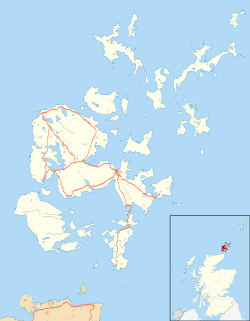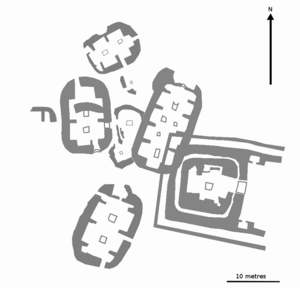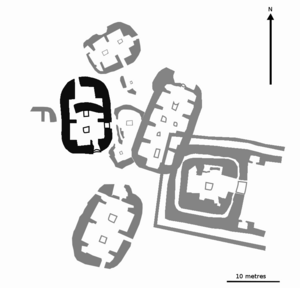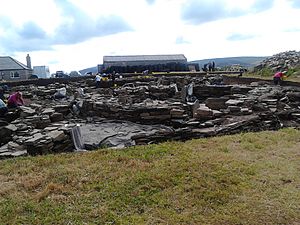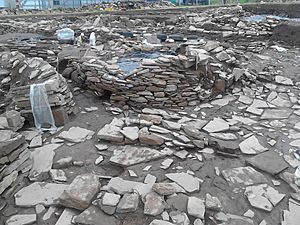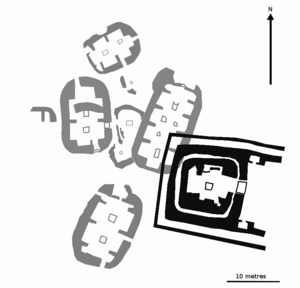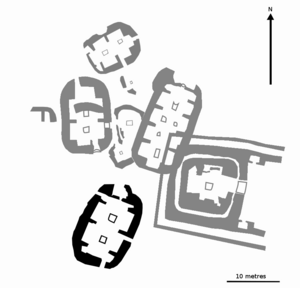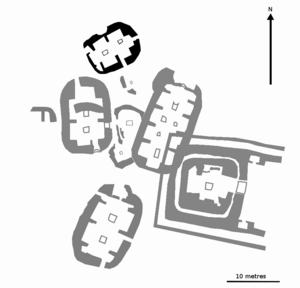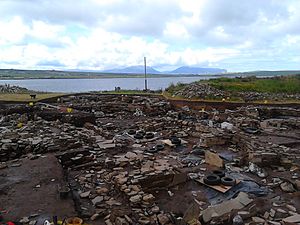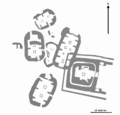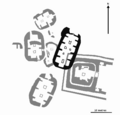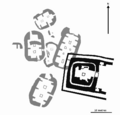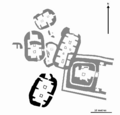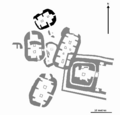Ness of Brodgar facts for kids
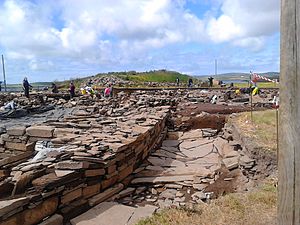
Excavations at the Ness of Brodgar.
|
|
| Location | Mainland, Orkney |
|---|---|
| Region | Scotland |
| Coordinates | 58°59′50″N 3°12′56″W / 58.9972265°N 3.215642°W |
| Type | Neolithic settlement or religious site |
| History | |
| Periods | Neolithic |
| Site notes | |
| Ownership | Ness of Brodgar Trust; also private ownership |
| Public access | Only by guided tour during excavation |
| Type | Cultural |
| Criteria | i, ii, iii, iv |
| Designated | 1999 (23rd session) |
| Part of | Heart of Neolithic Orkney |
| Reference no. | 514 |
| State Party | Scotland |
| Region | Europe and North America |
The Ness of Brodgar is an amazing archaeological site in Orkney, Scotland. It covers about 2.5 hectares (6.2 acres) of land. This ancient place sits between two famous stone circles: the Ring of Brodgar and the Stones of Stenness. It's part of a bigger area called the Heart of Neolithic Orkney, which is a World Heritage Site.
Archaeologists started digging here in 2003. They have found incredible things like decorated stone slabs and a huge stone wall. There's also a very large building that might have been a Neolithic temple. The oldest parts of the site were built between 3,300 and 3,200 years before the Common Era (BCE). The site was closed down and partly taken apart around 2,200 BCE. The Ness of Brodgar was even featured in a 2016 BBC Scotland TV show called Britain’s Ancient Capital: Secrets of Orkney.
Contents
Exploring the Ness of Brodgar Site
The Ness of Brodgar is on a narrow piece of land. It has the saltwater Loch of Stenness on one side and the freshwater Loch of Harray on the other.
Close by, you can see the Stones of Stenness and the Ring of Brodgar. A small bridge connects these two ancient sites. Other important places nearby include the Maeshowe burial mound and the Barnhouse Settlement. The ancient village of Skara Brae is also just a few kilometers away. It's possible that even more ancient sites are hidden under the lochs.
During the Neolithic period, the Loch of Stenness was likely a marshy area, not a deep lake. People from Skara Brae could have easily walked to the Ness of Brodgar. They could have taken part in ceremonies and then walked back home all in one day.
The buildings at the Ness of Brodgar were made from flagstone. This type of rock is common in Orkney and splits easily into flat pieces. This made it perfect for building with the tools available in Neolithic times. Some very thin stone pieces found suggest they might have been used as roof tiles. This is the first time such evidence has been found.
Important Buildings at Ness of Brodgar
The buildings at Brodgar are numbered in the order they were found. As archaeologists learned more, some numbers were no longer used. As of 2016, the main buildings are Structures 1, 8, 10, 12, and 14.
Structures 1, 8, 12, and 14 seem to have been built around 3,000 BCE. They stand on top of even older remains. These older parts have not yet been fully uncovered. Experts believe they date back to 3,300–3,200 BCE.
Structure 1: A Central Building
Structure 1 has a long and interesting history. It appears to have been built on top of an earlier building. It seems this structure was very important to the whole site. It was originally more than 15 meters (49 feet) long.
It was changed a lot within about a century of being built. Two doorways were blocked, a new one was added, and a new wall was built. Many pieces of stone art decorated this building. Some art was hidden inside the walls and could not be seen when the building was in use.
Some stones in Structure 1 were painted yellow, red, and orange. The paint was made from ochre, a pigment from haematite mixed with animal fat, milk, or eggs. This was the first time evidence of painted Neolithic buildings was found in Britain.
In 2015, the bones of a baby were found in a hidden spot in this building. The baby likely died around the time of birth.
Structure 8: Unique Discoveries
Structure 8 was built around the same time as Structure 1. It probably went up just after Structure 1 was finished. It had ten stone supports and ten recessed areas, plus six hearths (fireplaces).
There are at least two older buildings underneath Structure 8. The floor of Structure 8 sank a long time ago, causing its roof to fall in. Some of its stones were later used to build Structure 10.
Structure 8 was the first place at the site where stone roof tiles were found. It was also the first place where colored paint was discovered on the walls.
Archaeologists found finely made stone spatulas here. These look like flattened spoons and were crafted with great care. They don't show any signs of being used, so their purpose is still a mystery. Other finds included a mace head made from whalebone and a whale's tooth set in stone.
Structure 10: The "Temple-like" Building
Structure 10 was found in 2008. The archaeologists called it "temple-like." Its walls are 4 meters (13 feet) thick and still stand over 1 meter (3.3 feet) high. The building is 25 meters (82 feet) long and 20 meters (66 feet) wide. A standing stone with an hourglass-shaped hole was built into its walls.
Inside, there is a cross-shaped inner area. The building was surrounded by a paved pathway. It is thought to have been built around 2,900 BCE. It was partly rebuilt around 2,800 BCE, probably because it wasn't stable. This is the largest building of its kind in northern Britain. It would have been a very important landmark in the area.
Structure 10 was used until about 2,400–2,200 BCE. Then, it seems to have been "closed" in a very unusual ceremony. This event involved killing hundreds of cattle. The bones of about 400 cattle shin bones were found. These bones made up most of the animal bones at the site.
The bones appear to have been cracked to get out the marrow, which suggests a big feast happened. All the cattle seem to have been killed at one time. After the feast, whole bodies of several red deer were placed on top of the broken bones. Then, Structure 10 was mostly destroyed. This event likely marked the end of the Ness of Brodgar site.
Structure 12: Southernmost Discoveries
Structure 12 was built around 3,000 BCE. It has six stone supports, four recessed areas, and two hearths. This is the most southerly building found so far. However, archaeologists believe there are more buildings hidden further south underground.
Structure 12 was made of well-cut stone. But like other buildings here, it had structural problems and was partly rebuilt. A section added later to the north wasn't built as strongly as the original part.
This added section contained many pieces of grooved ware pottery. Some were very large pots. Some were made using techniques not seen anywhere else from the Neolithic period. Some pots were colored black, red, or white. The red came from ochre, and the black from soot. The source of the white color is still unknown.
The grooved ware pottery from Orkney is the oldest known in Britain. This style seems to have started in Orkney and then spread south.
Structure 14: Northernmost Building
Structure 14 was built around 3,000 BCE, at the same time as Structures 1, 8, and 12. Like them, it was built on top of older structures. It is the most northerly building found so far. It has three entrances, four stone supports, four recessed areas, and two hearths. It is similar in design to Structure 8, but larger.
Many stones from Structure 14 were removed long ago to be used elsewhere. Like all buildings except Structure 10, it seems to have been mostly taken apart by 2,600 BCE.
The different ends of this building seem to have been used for different purposes. Scientists are still testing the floor to figure out what those uses were.
An unusual axehead made from gneiss rock was found here. Also, an early Neolithic bowl was discovered, which might be older than grooved ware pottery.
Amazing Finds at Ness of Brodgar
The digs at Ness of Brodgar have uncovered several buildings. Some were used for ceremonies, and others for daily life. Archaeologists think there are likely more buildings nearby. They have also found pottery, burned animal bones, stone tools, and polished stone mace heads. Some stone slabs are decorated with geometric patterns, like diamonds, which are common at other Neolithic sites.
There are also remains of a large stone wall, sometimes called the "Great Wall of Brodgar." It might have been 100 meters (328 feet) long and 6 meters (20 feet) or more wide. It seems to cross the entire piece of land where the site is located. It might have been a symbolic barrier between the special ceremonial area and the everyday world around it.
In 2011, a baked clay object known as the "Brodgar Boy" was found. It looks like a small figure with a head, body, and two eyes. It was found in two pieces, the smaller one being 30 mm (1.2 inches). It's thought to be part of an even larger object.
In 2013, a beautifully carved stone was found in Structure 10. Experts called it "potentially the finest example of Neolithic art found in the UK for several decades." The stone has carvings on both sides. A few days later, archaeologists found a carved stone ball. Finding such an object still in its original place is very rare.
Recent discoveries include Skaill knives and hammer stones, and possibly another, even bigger wall. Archaeologists from Orkney College and from the universities of Aberdeen, Cardiff, and Glasgow are involved in the dig.
Ness of Brodgar and World Heritage Status
The Heart of Neolithic Orkney became a World Heritage site in December 1999. This important area includes the Ring of Brodgar, Maeshowe, Skara Brae, the Stones of Stenness, and other nearby sites. Historic Scotland manages the site. They describe its importance by saying:
"The monuments at the heart of Neolithic Orkney and Skara Brae show the amazing achievements of people in early times and isolated places. They were built around the same time as the first pyramids in Egypt and the first cities in India. These sites are incredibly well preserved for their age. They stand as a clear symbol of what early people could achieve, even far from what we call traditional centers of civilization."
The importance of the Ness of Brodgar was only discovered in 2003. So, it wasn't specifically mentioned when the World Heritage site was named in 1999. However, Historic Scotland says that the Ness of Brodgar "adds greatly to our understanding of the World Heritage Site."
Images for kids
See also
 In Spanish: Ness of Brodgar para niños
In Spanish: Ness of Brodgar para niños


